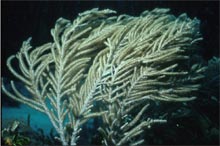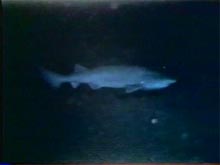
Within the Charleston Bump landscape are a host of strange creatures, including sponges, corals and other associated invertebrates that live attached to the rock or within the sediments. They depend on the movement of the water for their growth, survival and reproduction. Click image for larger view.
Turbulent Lifestyles
Stephen E. Stancyk
Brian Helmuth
University of South Carolina
If you’ve ever seen the way the wind sculpts sand dunes and mountainsides, or even the way trees in areas of high wind are twisted, you’re aware that wind and weather have an enormous effect on the shape of the landscape. Deep underwater on the sides of the Charleston Bump, the force of wind is replaced by that of water, but the effects are much the same. Large slabs of broken platforms along the seafloor indicate continual undercutting of the ledges and provide evidence of the active dynamics of ocean currents near this feature. The result is a complexly shaped series of mounds and mountains, valleys and depressions in which moving water slows down and speeds up, at times creating turbulent eddies and at others creeping to a near standstill. Within this landscape are a host of strange creatures, including sponges, corals and other associated invertebrates that live attached to the rock or within the sediments. They depend on the movement of the water for their growth, survival and reproduction.

A sixgill shark heads slowly into the strong currents on the Charleston Bump. The currents carry a lot of "marine snow" consisting of organic and inorganic (calcium) material. (mp4, 2.8 MB)
![]() Click image for video.
Click image for video.
In many ways, these benthic (bottom-dwelling) organisms are the ultimate couch potatoes: for many, the movement of water is just as necessary for their respiration as the movement of air into and out of your lungs is for yours. Most also rely on the movement of water for the delivery of food, which they filter or otherwise remove from the water as it moves past. If the flow of water is too slow, not enough food may be delivered to sustain their needs. Conversely, if water moves too quickly, they may not be able to effectively capture the food as it whizzes past.
Fortunately, these organisms are able to exercise some control over the rate of water flow over their surfaces via their shape. For example, some animals may be able to induce turbulence over their surfaces, thus increasing the rate of uptake of things like gases, nutrients and foods by projecting up into the flow. Many sea anemones and soft corals thrive in the highest-current areas, where they can passively extend their feeding structures into the current to catch food. Because of their soft bodies, these animals can adopt this strategy without fear of being broken by the strong water flow. Other organisms, like encrusting sponges, may be more “streamlined,” living close to the substrate to resist being broken or removed. Still other creatures, such as brittlestars, worms and clams, prefer more sheltered spots where particles of material tend to settle out and concentrate. The patterns of distribution of these sessile (attached) organisms may, in turn, have an effect on near-bottom fish and invertebrates through their productivity and via the creation of habitat.
The links between patterns of water flow and the types of organisms that live in each flow “regime” have been studied in habitats such as coral reefs and seamounts in the North Atlantic, but seldom have they been investigated in deep water, and never at the Charleston Bump. During this expedition, we will study large-scale patterns in water flow over the Bump and tie these to near-bottom flow using a series of “clod cards”. We can then relate patterns in flow to patterns in the shape and distribution of organisms that we observe from the submersible. During each dive, we will videotape the animals that we find on the bottom, and by analyzing the tape back aboard ship, we hope to learn something about how water flow influences the way organisms live on different parts of the Bump. Stay tuned to see if life at the bottom of the Bump is as wild and turbulent as we think it might be!
























